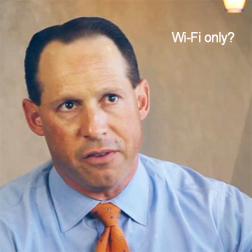 |
| Outlaw |
Wow. That is the first word that comes to mind after reading Jeff Hangartner's indie gaming articles a.k.a. confessionals at Gamasutra. Hangartner recently launched his own indie game studio,
Bulletproof Outlaws, to market his first iPhone game and the article shares some of his marketing experiences from the purview of business owner and
not a marketer.
The
series is a must-read for anyone in marketing, public relations, or social media because it's a rare opportunity to see an authentic, even transparent, client perspective. Even better, there is no throwing stones like the
Bruce Buschel article because Hangartner is all DIY.
On Social Marketing. Hangartner gives high marks to
social marketing, recognizing that it's one of the most important segments of any campaign today. He understands that social marketing might be "free," but not really free. There are hundreds of things a new indie game studio could do, and social media carries the one cost you never get back — time.
• One account on various networks is enough; it's too cumbersome to splinter your impact.
• Quality connections are more important than quantity; but weak follows can help early on for things like claiming your vanity url on Facebook.
• Social networks work better without spam; participation carries more leverage than broadcast.
• Blogs can be incredibly useful; but he recognizes that he loves to write more than most people.
Area For Improvement. From his own experience and admission, Hangartner gives some of the best advice early in the article: start early. The earlier, the better.
All too often, entrepreneurs think about social marketing (and all marketing) too late. People wait for the product, wait for the website, and wait for anything else they can think of. But the reality is that the last thing you want to do is work to develop a network at the same time you are launching a product.
On Traditional Marketing. Hangartner nails down the truth of
traditional marketing in that for most startups it requires a balancing act. You neither want to blow your rent check to gain additional leverage nor can you afford to hang on to every cent you make.
• Know the rules of any advertising program, including promo codes; they have strings, including who can review your product.
• Alexa can sometimes point you in the right direction; but it's also a lot of "mumbo jumbo."
• Impressions and clicks and purchases are not the same; find your own formula that works and then test it.
• Be wary and double check anyone who asks developers to pay for reviews; consider the ethics of it more than justifying it.
Area For Improvement. Like most marketers today, Hangartner is learning that numbers are important but searchable numbers tend to lie. Even here. I run different stat programs like many marketers and all of them tell a different story. What none of them tells is who, even on the lowest read days, whom those readers might be. Rather than discount anyone, you carefully weigh who you could help
make an influencer over night. Some of them only need a cause to champion and they haven't found the right one and all of them beat anyone you might pay for a positive review.
On Maintainence And Public Relations. Hangartner entitled the article
Game Related and Maintenance, but mostly it's about public relations (and a recap of some other marketing and social media details). Incidentally, he even proves my point about blogs with his own. One day, his seldom read blog jumped from nothing to almost 6,000 visitors before tapering off.
• Press releases, press kits, and DIY trailers are easier than ever to make; no help needed (maybe).
• There is always an ask on the table for exclusive stuff; he suggests waiting but is tempted.
• Continually check banner advertisement outcomes and don't keep the ones that are under performing.
• Always keep some level of maintenance going because people drift off if you are not present.
Area For Improvement. Specific to what Hangartner calls a press kit: it's mostly a sales kit. That's okay. As a reviewer, some of the content can help clear things up quickly. In other areas, the sales copy gets in the way of any real story. It's also missing something else. One vertical screenshot is something I wish all developers (and bands) had on hand before I have to slice their pictures to fit.
More importantly, the public relations pro he doesn't want to hire for a release (maybe a good idea; maybe not) might help him wade through the exclusive content scenario (if they are any good). While everyone wants exclusive content, I'd be wary of what it might do to every other relationship he is trying to establish. Likewise, the time he invested looking for answers might have taken minutes had he had at least one professional worth more than $5 per hour to ask.
On Psychology. This
was one of my
favorites of the four articles he has written so far, and the one that convinced me to make it a must-read for communication students. It's powerful and insightful because not all entrepreneurs share this stuff with their marketing teams. As the collective articles allude, clients juggle much more than their marketing and communicator contracts. And that is the sharpest point for any marketing and public relations person to take away: you are important but not the most important part of any company puzzle.
• As a business owner, expect highs and lows; always keep your ego and attachment in check.
• Checking the stats daily is addictive; there is nothing wrong with it until it dictates your emotions.
• Everybody has an opinion, especially friends; listen, but don't think you have to act on advice.
• Handing out business cards is less important than collecting them; keep in touch with the people you collect cards from.
Area For Improvement. Hangartner does a good job outlining the psychology of being a developer and an entrepreneur. Having worked with so many, I've seen first hand what many of them go through — especially game developers, artists, and other creative types. It's hard not to take some things personally when you put so much of your person in the creation. There is no way to improve on his experience, with the exception of one thing — finding one or two people whose opinion you can value will go a long way. The only downside is that many developers and entrepreneurs find the wrong people to trust or shuffle through a deck of them based on nothing more than what their gut says today.
This post isn't advice for Hangartner. It's advice for marketing and public relations.
Of course, this post wasn't for Hangartner. It's for marketing and public relations students as well as practicing professionals, especially those who always see the world from their perspective and cannot understand why their opinions don't carry more weight with their clients or prospects.
The answer is simple enough. Marketing, public relations, and social media aren't the one-dimensional exercise that so many people in the profession like to pretend they are. This series of articles ought to go a long way in helping students and professionals see that, at least I hope so.
Clients have hundreds of things on their minds, hundreds of people with myopic suggestions, and the constant fear of failure (which sometimes carries the consequence of paying the rent). They can't be like the firm or agency that has worked with dozens of different clients, experience that eventually teaches us how to distance ourselves from the attachment of the client (but not the work) or else we might find ourselves heartbroken on a monthly basis.
For us, there might always be another client. For some of the people who hire us, there is nothing else. Treat them fairly. And, even when they are wrong on some points, always take the time to listen to their ideas. They know more than you think. You don't have to educate them about every detail, but always be open to dialogue because nowadays, especially, many of them are grasping at everything.
Advice for Hangartner? He's doing most of it right. I only wish he would expand his target audience. They aren't gamers and other developers, which is where most of his efforts have been. There are people, on the other hand, who never actively look for games but would be interested in his offering.









































